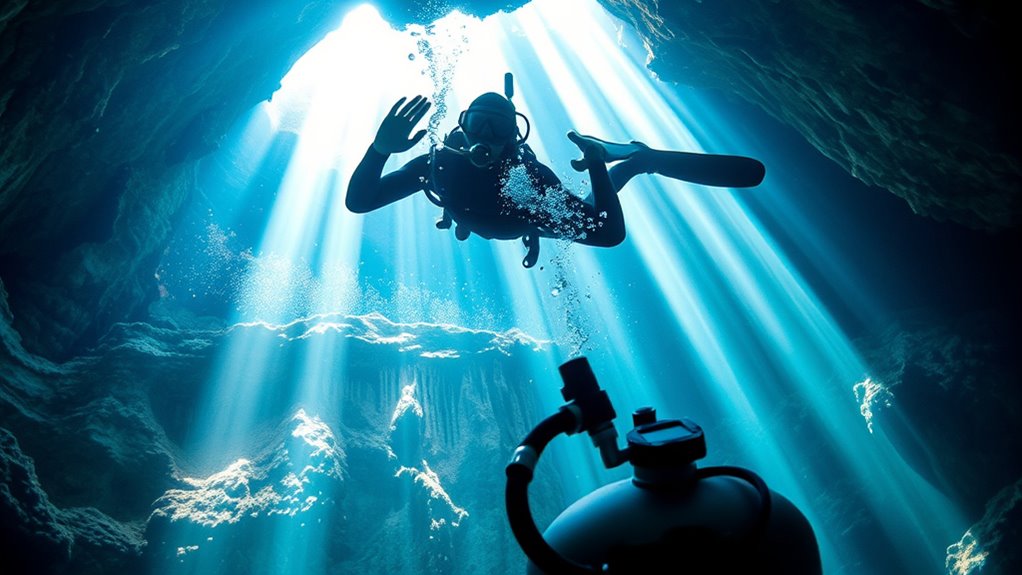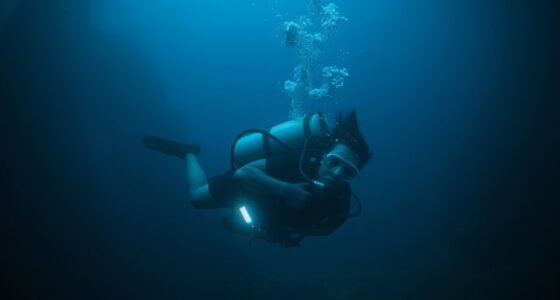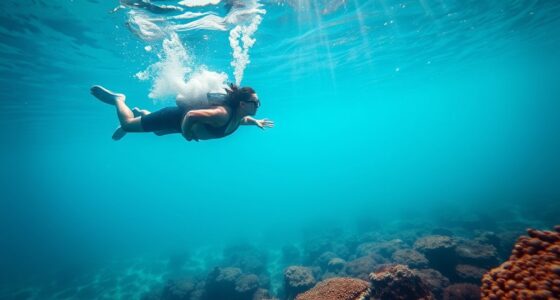Cave diving requires specialized training and strict safety protocols. You need to understand underwater navigation, equipment maintenance, and risk management techniques. Familiarizing yourself with your team’s gear is essential for effective communication and coordination. Always check your equipment before diving, ensuring everything’s functioning correctly. Make a solid plan that includes entry and exit points. Effective training prepares you for potential hazards. To enhance your skills and safety, there’s more to explore about this exciting adventure.
Key Takeaways
- Enroll in reputable cave diving courses to learn essential techniques and safety protocols from experienced instructors.
- Develop underwater navigation skills to handle cave-specific challenges and prevent disorientation during dives.
- Regularly inspect and maintain your diving equipment to ensure it is functioning properly before every dive.
- Establish clear communication signals and a dive plan with team members to enhance coordination and safety.
- Conduct thorough risk assessments to identify potential hazards and inform safe diving practices in cave environments.

Cave diving can be an exhilarating adventure, but before you plunge into the depths, you need to understand the basics. One of the most vital elements of cave diving is mastering underwater navigation. Unlike open water, caves present unique challenges that can easily disorient even the most seasoned divers. Familiarizing yourself with the cave’s layout and potential hazards is essential. You’ll want to practice using compasses and other tools that help you maintain your sense of direction. Learning to execute a proper kick and understand natural light sources can also guide you through tight spots. Remember, in a cave, it’s easy to lose track of your entry point, so always have a reliable plan in place.
Master underwater navigation to conquer the unique challenges of cave diving and ensure a safe adventure.
Next, let’s talk about equipment maintenance. Your gear is your lifeline while diving, and keeping it in top condition is non-negotiable. Regularly check your diving equipment for wear and tear. Inspect your tanks, regulators, and wetsuits before every dive. A small issue can become a significant problem underwater, so don’t take shortcuts. Make sure your lights are operational; caves can be pitch-black, and a reliable light source is essential for safe navigation. Make it a habit to clean and dry your equipment after each dive. Saltwater and dirt can compromise your gear if left unchecked.
When you’re gearing up for a dive, remember to familiarize yourself with your buddies’ equipment too. You’ll want to verify everyone’s gear is functioning properly. You never know when you’ll need to rely on a fellow diver’s backup gear. Practice communication signals and establish a clear plan before entering the water. This teamwork will enhance your safety and enjoyment.
Training is another critical aspect of cave diving. It’s not something you should jump into without proper instruction. Enroll in a reputable cave diving course that focuses on both theory and practical skills. Experienced instructors will guide you through essential techniques, ensuring you’re prepared for the unique challenges of cave diving. They’ll help you develop your underwater navigation skills and thoroughly educate you about the risks involved. Additionally, understanding the importance of risk assessments can significantly improve your safety and decision-making while diving.
Frequently Asked Questions
What Equipment Is Essential for Cave Diving?
For cave diving, you’ll need essential equipment like a high-quality wetsuit, dive tank, regulator, and underwater navigation tools. Don’t forget your buoyancy control device and dive computer. Regular cave equipment maintenance is vital to guarantee everything’s functioning properly. You should also familiarize yourself with underwater navigation techniques, as they’ll help you stay oriented in the often disorienting cave environment. Proper gear and skills can make your dive safe and enjoyable!
How Do I Choose a Cave Diving School?
To select a cave diving school, look for one that emphasizes cave mapping and underwater navigation skills. Check for certifications from recognized agencies and read reviews from past students. You’ll want instructors with extensive experience and a solid safety record. Visit the school, ask about their training methods, and make sure they use up-to-date equipment. It’s essential to feel comfortable with the environment and the instructors before committing to a course.
Are There Age Restrictions for Cave Diving?
Yes, there are age restrictions for cave diving. In many places, you must be at least 18 years old to dive independently. However, some schools might allow minors to participate with parental consent and under specific legal requirements. Curiously, divers under 18 represent about 10% of all cave divers, highlighting the importance of safety and proper training. Always check local regulations and dive shop policies before planning your adventure!
What Are the Costs Associated With Cave Diving?
Cave diving can involve significant costs. You’ll need to take into account gear expenses, which can range from hundreds to thousands of dollars. Training courses also add to the cost implications, often running several hundred dollars. Insurance considerations are vital too; you should invest in a policy that covers cave diving. Overall, budgeting for gear, training, and insurance can make your dive experience safer and more enjoyable, so plan accordingly!
How Can I Prepare Physically for Cave Diving?
Did you know that about 80% of cave diving accidents stem from inadequate physical and mental preparation? To prepare physically for cave diving, you need to build your endurance through regular cardio workouts, like running or swimming. Strength training’s important too, focusing on your core and legs. Don’t forget mental preparation; practice visualization techniques to handle potential challenges underwater. This combination will boost your confidence and help you enjoy the adventure safely.
Conclusion
So, you’re all set to explore the breathtaking depths of a cave, armed with your training and safety gear. Isn’t it funny how you can feel so alive while being surrounded by darkness? Just remember, the real adventure isn’t just about the stunning underwater views; it’s also about avoiding the urge to panic when things get tight. Dive smart, stay calm, and who knows? You might just find yourself wishing for a little less excitement on your next dive!










